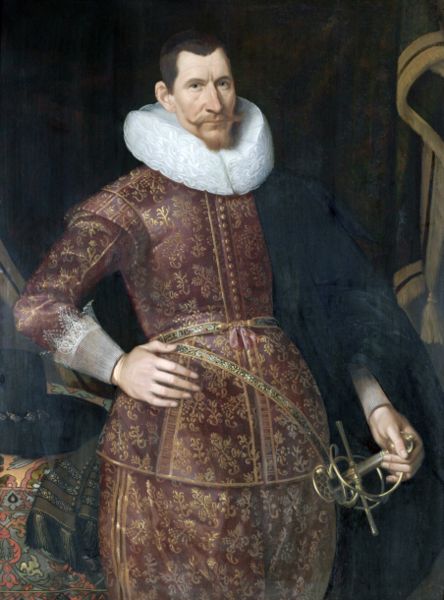Think that you may own a portrait of Jan Pieterszoon Coen? We authenticate, appraise and issue Certificates of Authenticity (COA) for all portraits of Jan Coen.

Portrait of Jan Coen by Jacob Waben
Jan Pieterszoon Coen was an officer of Dutch East India Company (VOC) in the early seventeenth century, holding two terms as its Governor-General of the Dutch East Indies. He was long considered a national hero in the Netherlands, for providing the impulse that started the VOC on the path to dominance in Indonesia through his aggressive policies. A quote of his from 1618 is well known, "Despair not, spare your enemies not, for God is with us" ("Dispereert niet, ontziet uw vijanden niet, want God is met ons" in Dutch). However in the 20th century he was looked at in a more critical light, as his acts of cruelty and violence approaching genocide were re-examined.
Coen was unpopular with many in his time on account of strict governance and a habit of harsh criticism, at times directed even at the 17 Lords of the VOC (for which he was reprimanded). He was strict with his subordinates and merciless with his opponents. His willingness to use violence to obtain his ends was too much for many, even for such a relatively violent period of history. When Saartje Specx, a girl who he had been entrusted to care for, was found in a garden in the arms of a soldier, Pieter Cortenhoeff, Coen showed only small mercy in having her whipped instead of drowned immediately in a vat as he first intended. Cortenhoeff was beheaded.

Portrait of Jan Coen, artist unknown, first half of the 17th century
Coen was born at Hoorn on 8 January 1587 and in 1601 travelled to Rome to study trade in the offices of Justus Pescatore. Joining the Dutch East India Company (VOC), he made trading voyages to Indonesia in 1607 and 1612. On the second trip, he commanded two ships and in October 1613 was appointed accountant-general of all VOC offices in Indonesia and president of the head office in Bantam and of Batavia (now Jakarta). In 1614, he was made director-general, the second highest function. On 25 October 1617 the 17 Lords of VOC appointed him their fourth governor-general in the East Indies (of which he was informed on 30 April 1618).
On account of disputes at the head office in Bantam with Chinese, Banten and the English, the VOC desired a better central headquarters. Coen thus directed more of the company's trade through Batavia, where it had established a factory in 1610. However not trusting the native ruler, he captured and destroyed much of the city, deciding in 1618 to build a fort.
He also set about establishing a monopoly over the trade in nutmeg and mace which could be obtained only from the Banda Islands. The inhabitants of Banda had been selling the spices to the English, despite contracts with the VOC which obliged them to sell at low prices. In 1621, he led an armed expedition to Banda, taking the island of Lonthor by force. Most of the inhabitants were killed or exiled to other islands.

Statue of Jan Coen
On 1 February 1623, he handed his post to Pieter de Carpentier and returned to the Netherlands, where he became head of the VOC chamber in Hoorn and worked on establishing new policies. During his absence from the East Indies, difficulties with the English where exacerbated by the Amboyna Massacre. On 3 October 1624 he was reappointed governor-general in the East Indies, but his departure was hindered by the English. In 1625, he married and in 1627 departed incognito for the East Indies with his wife and her brother and sister, starting work on 30 September 1627. After his arrival, the English abandoned Batavia and established their headquarters in Bantam.
Twice during Coen's term in office, Sultan Agung of Mataram besieged Batavia, in 1628 and 1629. However, Agung's military was poorly armed and had inadequate provisions of food, and was never able to capture the city.
During Agung's second siege Coen suddenly died on 21 September 1629. There is folklore at Agung's graveyard at Imogiri, in central Java, that parts of Coen's remains were secreted away from their Batavia resting place, and placed under the stairway to Agung's grave, as all pilgrims to the grave would walk over them.
Documentation about portraits of Coen are virtually non-existent, and the portraits themselves are few and far between. It is likely that many were destroyed, as he was not a well-like historical figure. However, if a Coen portrait were to have survived the centuries it would be quite a rare find indeed.
Still wondering about a portrait in your family collection? Contact us... it could be a portrait of Jan Pieterszoon Coen.
